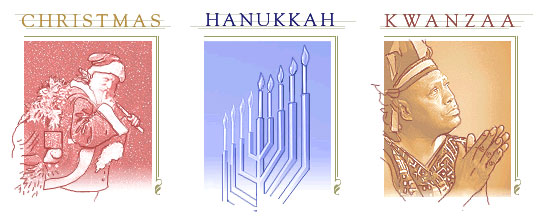The History of The Holidays
January 1, 2018
Each year, the holidays come around quickly and unexpectedly. Students and parents and employers and employees – among others – work tirelessly through this time, struggling to enjoy a bit of seasonal fun all while earning the money to shop, to decorate, and to feast with their families. Inevitably so, many adults view these celebrations as labor rather than as break.
As sad as this may seem, gift-givers and party-throwers sure are kept on their toes during the weeks and months surrounding Christmas, Hanukkah, and Kwanzaa.
There are trees to be chopped and sold and decorated, lights to be strung and hung about, presents to be bought and wrapped in shimmering paper. There are menorahs to be placed and lit each night, eight Hanukkah gifts to be purchased and given, many delicious latkes and donuts to be cooked and served. There are the seven candles of the kinara to be burned in honor of the Gods, the special feast of the Karamu to be held and enjoyed, tasty African cuisine to be prepared and presented.
Undoubtedly, the holiday season is a time of tradition. It is a grand celebration of love and of joy for all, regardless of which holiday one celebrates or what religion they practice or the culture they align with. The three main holidays held in December each bring about laughter and cheer, and make the last few weeks of the month, in short, “the most wonderful time of the year.”
Though, each holiday is scarcely just mere fun.
Anyone with a menorah, a Christmas tree, or a kinara in his or her home should know and understand the origins of these beloved holiday(s). Even further, it is also important to expose oneself to the customs of the other celebrations and where they came from. Consumed by the luring smells of Santa’s cookies, by the delicious crisp of a fried latke, and perhaps by the savory scents of Groundnut stew, many of us ignore the beautiful beginnings of our favorite holidays.
Thus, the following is brief overview of each celebration and how it came about:
Kwanzaa – Unlike the other two, this holiday is solely based on culture rather than on religion. It is a celebration of the African harvest, just as the word “Kwanzaa” translates to “first fruits” in Swahili. Lights and gifts are unimportant to those who celebrate Kwanzaa, for the real purpose is to do special things for friends and family, and to promote unity and strength. Taking place from December 26 to January 1, a candle is lit everyday over the course of the week it is observed. The candles, in order, represent unity, self-determination, responsibility, economics, purpose, creativity, and faith.
Hanukkah – This eight-day Jewish holiday directly translates to “dedication” in Hebrew, and is most commonly known as the Festival of Lights. Hanukkah (Chanukah) honors the rededication of the holy temple in Jerusalem following the victory of the Jews in 165 B.C.E. against the Syrians. Every year, Hanukkah takes place on the twenty-fifth day of the month of Kislev (between late November and late December). Traditionally, one of eight candles on the menorah is lit each consecutive night, where those that had been burned the night before are lit again as well until it is full on the last day. The ninth candle stands tall in the middle of the other eight, and is called the “shamash,” or “servant.”
Christmas – What has now become a traditional celebration of trees dressed in red and green and tales of Old Saint Nick providing children with gifts on Christmas night, this December 25th holiday has grown so far beyond its beginning that its true purpose is so easily forgotten. Roman Catholics and Protestants recognize and honor the birth of Jesus on Christmas day. Many wonder, “well, where did Santa Claus and the North Pole come from then?” Simply put, these extra details are none more than extra details. Saint Nick was a Christian bishop who helped the needy, then transforming into Santa for the benefit of children. Over time, creative stories were written and soon enough, the story of Christmas was complemented by red-nosed reindeers, talking snowmen, and toy-making elves. Now, Christmas has morphed into a celebration of love for many, especially for those who do not recognize the religious aspect of it.
Wishing all a wonderful Kwanzaa, Hanukkah, and/or Christmas, I hope there are no further misconceptions of the three holiday celebrations.
Now, instead of just spreading love and joy, spread knowledge and understanding as well, and the season will be even brighter than it had been before.
Happy Kwanzaa, Happy Hanukkah, and Merry Christmas from the PawPrint!
